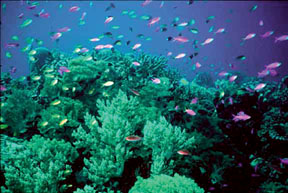
Bauna-Vista Coral Reef: 'Little Sinharaja' at the bottom of the sea
What do you know about coral reefs? You sure must have heard about
the Great Barrier Reef of Australia, one of the most famous coral reefs
in the world, and the Hikkaduwa Coral Reef, one of our Sri Lankan
treasures. Coral reefs add beauty to the sea world and are also a
blessing in disguise for the islands, because these reefs slow down the
ocean waves, minimising coastal erosion.

Today, we are featuring one of the most beautiful coral reefs in Sri
Lanka, the Bauna-Vista Coral Reef, which is situated a few miles away
from the Galle town. The name 'Bona Vist', which means 'beautiful
scenery' was given by the Portuguese, but later, according to the Latin
pronunciation it had changed to 'Bauna-Vista'.
When you stand by this coral reef, you get a magnificent view of the
Galle Fort and Harbour.According to the Ramayana, Luxmana, Rama's
brother had been injured by an arrow shot by Rawana. So, Rawana himself
had arranged a doctor for him.
This ayurvedic doctor had wanted a herb called 'Sanjeewani' to heal
the wound. Hanumantha was sent here to find and bring this herb to
Himalaya, but he was not exactly sure what the herb was. So, he had
uprooted part of the mountain containing the herb and taken it with him.
On his way, two pieces of the mountain fell off; one is said to be at
Ritigala and the other at Unawatuna. The latter mountain is located
close to the Bauna-Vista.
The reef slopes down randomly and opens to the sea. It is home for
several varieties of small fish as well as some bigger ones. According
to studies done before 1998, this was rated as the most beautiful coral
reef in Sri Lanka, because of its shape, position and the bio-diversity.
The geographical difference around the reef adds to its beauty.
The value of a coral reef is usually measured by its bio-diversity.
The area it covers, number of coral varieties and number of fish
varieties are some of the other factors. The number of butterfly-fish
varieties in a reef is especially considered as a measure because these
fish have their own eating habits and natural habitats. If there are
more butterfly-fish varieties, this means there is more variation in the
habitat. The Bauna-Vista Reef has 29 butterfly-fish varieties out of 36
varieties found all over the country.
Another measurement of a coral reef is the percentage of the live
coral covering. At Bauna-Vista, this was almost 70 per cent before 1998.
At that time, there were 183 coral varieties in Sri Lanka. At the
beginning of 1998, an Australian scientist found four new coral
varieties from Sri Lankan reefs. Three out of this were from Bauna-Vista,
and aren't seen anywhere else in the world.
Tragedy in 1998
We mentioned that there were 183 coral varieties before 1998. So,
what happened in 1998? This was the most unfortunate year for Sri
Lanka's coral reefs.

Because of the 'El-nino effect', warm surges, which started from
Seychelles and Diego Garcia Island around Madagascar came towards our
South and Western coral reefs. The usual temperature of the sea water,
which was 27-28 degrees Celsius, rose up to 36 degrees.
As a result, the algae, main food of the coral, started to die.
Within four days, the corals also started dying without food. It was
like a snow fall at the bottom of the sea. Because of this, the coverage
of coral reefs declined at Unawatuna, from 80 per cent to two per cent.
At Hikkaduwa, it declined from 35 per cent to five per cent. The
reefs at Kabalana and Akurala were fully destroyed and at Bauna-Vista,
it came down to 20 per cent from 70 per cent. The remaining part of the
Bauna-Vista is still very precious. Today, the corals are growing again,
with the reef at Bauna-Vista now having grown up to 40 per cent. The
percentage of fish and other vertebrates have also increased.
This coral reef is growing faster, when compared to other reefs.
According to sources, this is the best coral reef that they can use to
spread new coral reefs around the island.
How corals are formed
There are two major types of corals named 'Zooxanthellate' and 'Azooxanthellate'.
Corals are made by a creature called coral polyp. They may vary in size
from 1 mm to 8 inches. These polyps live together, but the bigger ones
live alone.
Algae live inside the cells of the coral polyps. They absorb the
carbon dioxide in the water and produce oxygen and food for coral
polyps. So, the coral polyps have no worries about looking for food, and
have the ability of growing.
The colour and the growth rate of the reef depend on the algae that
combine with the coral polyps. No matter how big the coral reef is, the
live coral comprise just a thin layer. The rest are all skeletons left
by dead corals.
Compiled by Janani Amarasekara. |


